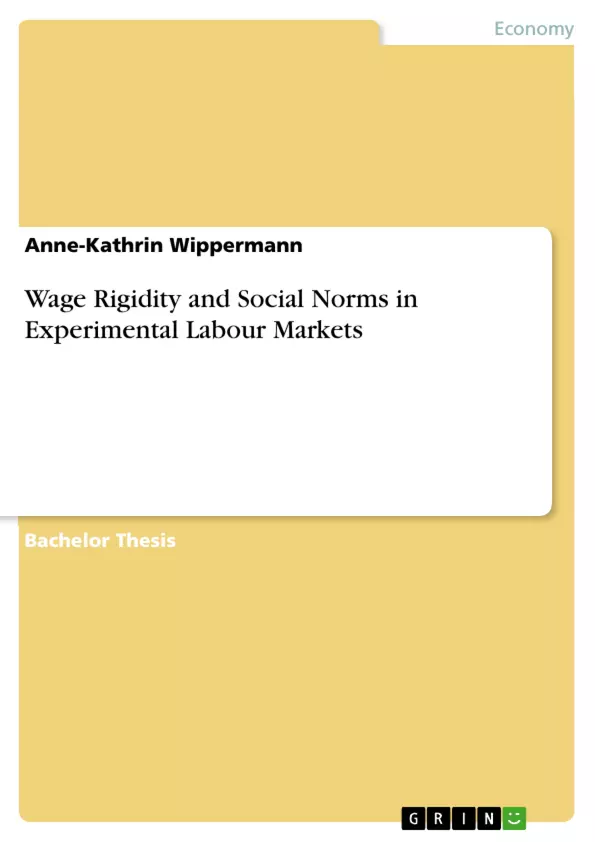Are wages rigid, and if so, why? The question raised has attracted economists’ attention ever since Keynes (1936, p. 289) suggested that wages were rigid and could lead to involuntary unemployment (Gächter, 2001, p. 478). This wage rigidity can be defined as the tendency of wages to react slowly, if at all, to excess labour supply and/or demand (Wachtel, 1994, p. 482). Keynes’ theory is at odds with the neoclassical model of the labour market, in which wages are flexible and therefore full employment at a market-clearing wage will ultimately be reached (Fischer and Heier, 1983, p. 56).
Due to the clash between Keynes’ theory and the neoclassical model, a lively discussion among economists arose as to whether wage rigidity existed or not. Some economists, such as Lucas and Rapping (1969, p. 748), claimed that wage rigidity was an illusion and that existing unemployment was voluntary, i.e. real wages were below workers’ reservation wages. Others claimed that wages were rigid and started to implant sociological findings into economic models, which gave further explanations as to why wage rigidity existed.
As a consequence of this debate it became clear that evidence was needed as to which of the models and theories actually applied to real world labour markets. Some economists went about this by conducting surveys in the labour market (see, e.g., Bewley, 1999, and Campbell III. and Kamlani, 1997). Others used experimental methods to simulate labour markets and test theories of wage rigidity for their robustness. Their findings, which generally confirm the sociological approaches to wage rigidity, will be the basis of this paper.
Inhaltsverzeichnis (Table of Contents)
- I. INTRODUCTION
- 1.1 The History of Wage Rigidity in Economic Thought
- 1.2 Layout of the Paper
- II. SOCIAL NORMS AND THE LABOUR MARKET
- 2.1 The Neoclassical (Labour) Market
- 2.2 The Influence of Social Norms
- 2.2.1 Fairness in the Labour Market
- 2.2.2 Reciprocity in Wage Bargaining
- III. THEORIES OF WAGE RIGIDITY BEYOND THE NEOCLASSICAL LABOUR MARKET
- 3.1 The Gift Exchange Model
- 3.2 Fair Wage-Effort Hypothesis
- IV. WAGE RIGIDITY IN EXPERIMENTAL ECONOMICS
- 4.1 The Labour Market in Experimental Economics
- 4.2 Testing the Model: Theories of Wage Rigidity in Experimental Labour Markets
- 4.2.1 Experimental Design of Gift-Exchange Games
- 4.2.2 Experimental Results
- 4.2.3 Introducing Wage References into the Game
- 4.2.4 Experimental Evidence
- 4.3 Social Norms in Experimental Labour Markets: Reciprocal Altruism and Unconditional Fairness vs. Reputation
- 4.4 The Effect of Third Party Intervention in an Experimental Labour Market
- 4.5 On the Robustness of Experimental Findings
- 4.5.1 Real Effort Experiments
- 4.5.2 The Effects of Social Framing in the Laboratory
- 4.5.3 Raising the Stakes: The Labour Market as a High Stake Game
- V. SUMMARY AND CONCLUSION
Zielsetzung und Themenschwerpunkte (Objectives and Key Themes)
This paper examines the role of social norms in labor markets and their impact on wage bargaining. It investigates whether social norms can adequately explain wage rigidity by analyzing sociological, theoretical, and experimental findings. The work explores how the inclusion of social norms challenges the neoclassical rational choice model and its implications for understanding labor market dynamics.
- The influence of social norms on wage bargaining and labor market outcomes.
- The limitations of the neoclassical model of the labor market in explaining wage rigidity.
- The development and testing of alternative theories of wage rigidity based on social norms, such as the gift exchange model and the fair-wage effort hypothesis.
- The empirical evidence from experimental economics supporting the role of social norms in wage rigidity.
- The robustness of experimental findings and their applicability to real-world labor markets.
Zusammenfassung der Kapitel (Chapter Summaries)
The introduction provides a historical overview of the concept of wage rigidity in economic thought, highlighting the debate between Keynesian and neoclassical perspectives. It outlines the paper's structure and objectives.
Chapter II delves into the role of social norms in the labor market, contrasting the neoclassical approach with the influence of social norms like fairness and reciprocity. It explores how these norms affect wage bargaining and labor market dynamics.
Chapter III presents prominent theories of wage rigidity beyond the neoclassical model, including the gift exchange model and the fair-wage effort hypothesis. These theories incorporate social norms and provide alternative explanations for observed wage rigidity.
Chapter IV investigates experimental evidence on wage rigidity in simulated labor markets. It discusses the design and results of experiments testing the validity of the theories presented in Chapter III. The chapter explores the role of social norms in shaping experimental outcomes and examines the robustness of experimental findings.
Schlüsselwörter (Keywords)
This paper focuses on the interplay of social norms, wage rigidity, and labor market dynamics. Key concepts include fairness, reciprocity, gift exchange, fair-wage effort hypothesis, experimental economics, and the robustness of experimental findings.
- Quote paper
- Anne-Kathrin Wippermann (Author), 2006, Wage Rigidity and Social Norms in Experimental Labour Markets, Munich, GRIN Verlag, https://www.grin.com/document/57064



